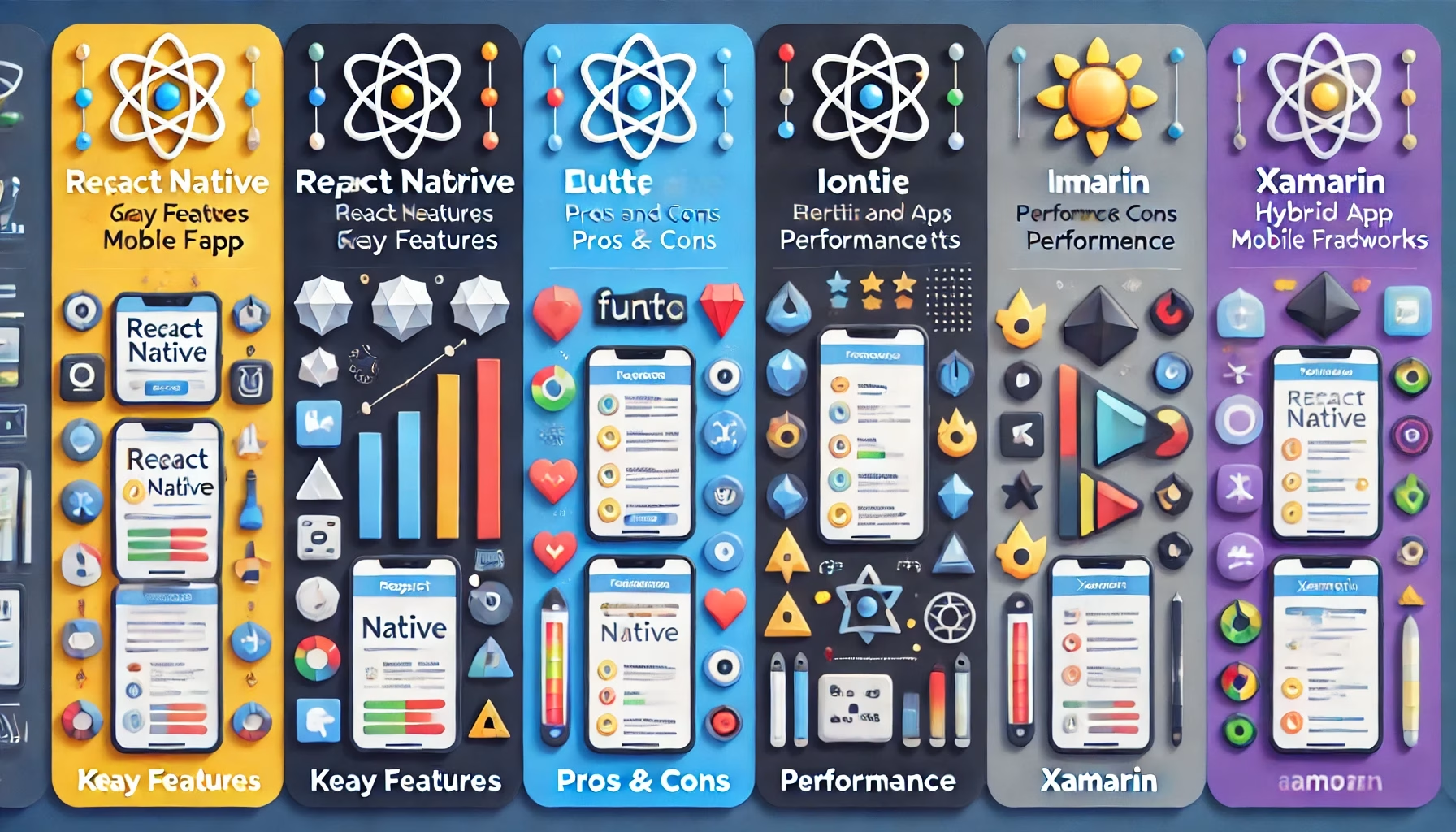Introduction
In today’s fast-paced digital landscape, businesses and developers seek cost-effective, scalable, and high-performance solutions for mobile app development. Hybrid mobile application frameworks have gained significant popularity as they enable developers to build apps that work on both iOS and Android using a single codebase. However, choosing the right framework can be challenging given the multitude of options available.
This blog provides a detailed comparison of the top hybrid mobile application frameworks, including React Native, Flutter, Ionic, Xamarin, and NativeScript, highlighting their advantages, limitations, and best use cases.
What is a Hybrid Mobile Application?
A hybrid mobile application combines elements of both native and web applications. These apps are developed using web technologies like HTML, CSS, and JavaScript but run within a native shell, providing access to device capabilities while maintaining cross-platform compatibility.
Top Hybrid Mobile Application Frameworks
Let’s explore the most widely used hybrid mobile frameworks and compare their features.
1. React Native
Overview:
Developed by Facebook, React Native is one of the most popular hybrid app development frameworks. It allows developers to use JavaScript and React to create natively-rendered mobile applications.
Pros:
- High performance due to native components
- Large community support
- Reusable components across platforms
- Hot reloading for fast development
Cons:
- Performance is slightly lower than fully native apps
- Complex animations may require native modules
Best For:
- Applications requiring a native-like experience with fast performance (e.g., Instagram, Facebook, Airbnb)
2. Flutter
Overview:
Flutter, developed by Google, uses the Dart programming language and a unique widget-based UI framework to create visually rich applications.
Pros:
- High performance with a compiled language (Dart)
- Extensive widget library for a native-like UI
- Hot reload for fast development
- Single codebase for multiple platforms
Cons:
- Larger app size compared to other frameworks
- Learning curve for developers unfamiliar with Dart
Best For:
- Apps that require high-performance graphics and custom UI (e.g., Alibaba, Google Ads, Reflectly)
3. Ionic
Overview:
Ionic is a popular open-source framework that uses web technologies (HTML, CSS, JavaScript) along with Apache Cordova to build cross-platform mobile applications.
Pros:
- Rapid development using web technologies
- Large library of UI components
- Strong community and extensive plugins
Cons:
- Performance is lower compared to React Native and Flutter
- Relies on WebView, which may impact responsiveness
Best For:
- Apps requiring fast development with a web-based approach (e.g., MarketWatch, Pacifica)
4. Xamarin
Overview:
Owned by Microsoft, Xamarin allows developers to use C# and .NET to build hybrid applications with near-native performance.
Pros:
- Native-like performance
- Single codebase for Android, iOS, and Windows
- Access to native APIs
Cons:
- Larger app size
- Requires knowledge of C# and .NET
- Limited community support compared to React Native and Flutter
Best For:
- Enterprise applications and businesses already using Microsoft technologies (e.g., UPS, Alaska Airlines)
5. NativeScript
Overview:
NativeScript is an open-source framework that allows developers to build hybrid apps using JavaScript, TypeScript, Angular, or Vue.js.
Pros:
- Direct access to native APIs
- Good performance
- Works with multiple JavaScript frameworks
Cons:
- Smaller community compared to React Native and Flutter
- Steeper learning curve
Best For:
- Apps that require deep native integration while maintaining a hybrid approach
Comparison Table
| Framework | Language Used | Performance | UI Flexibility | Community Support | Learning Curve |
|---|---|---|---|---|---|
| React Native | JavaScript | High | High | Large | Moderate |
| Flutter | Dart | Very High | Very High | Growing | Steep |
| Ionic | JavaScript | Moderate | Moderate | Large | Easy |
| Xamarin | C# | High | High | Moderate | Steep |
| NativeScript | JavaScript | High | High | Moderate | Steep |
How to Choose the Right Framework?
When selecting a hybrid mobile application framework, consider the following factors:
- Performance Needs: If performance is a priority, choose Flutter or React Native.
- Development Speed: If you need a faster development cycle, Ionic or React Native is a good choice.
- Native-Like Experience: Choose Flutter or Xamarin for apps requiring a near-native experience.
- Community and Support: React Native has the largest community, making it easier to find solutions and support.
- Technology Stack: Consider your team’s expertise—JavaScript developers may prefer React Native or Ionic, while C# developers may choose Xamarin.
Conclusion
Hybrid mobile application frameworks offer a cost-effective way to build cross-platform apps without sacrificing performance or user experience. React Native and Flutter are the most preferred choices due to their high performance and extensive community support. However, the best framework depends on your specific project requirements and technical expertise.
Choosing the right framework is a crucial decision that impacts your application’s success, so evaluate your options carefully before making a final choice.

